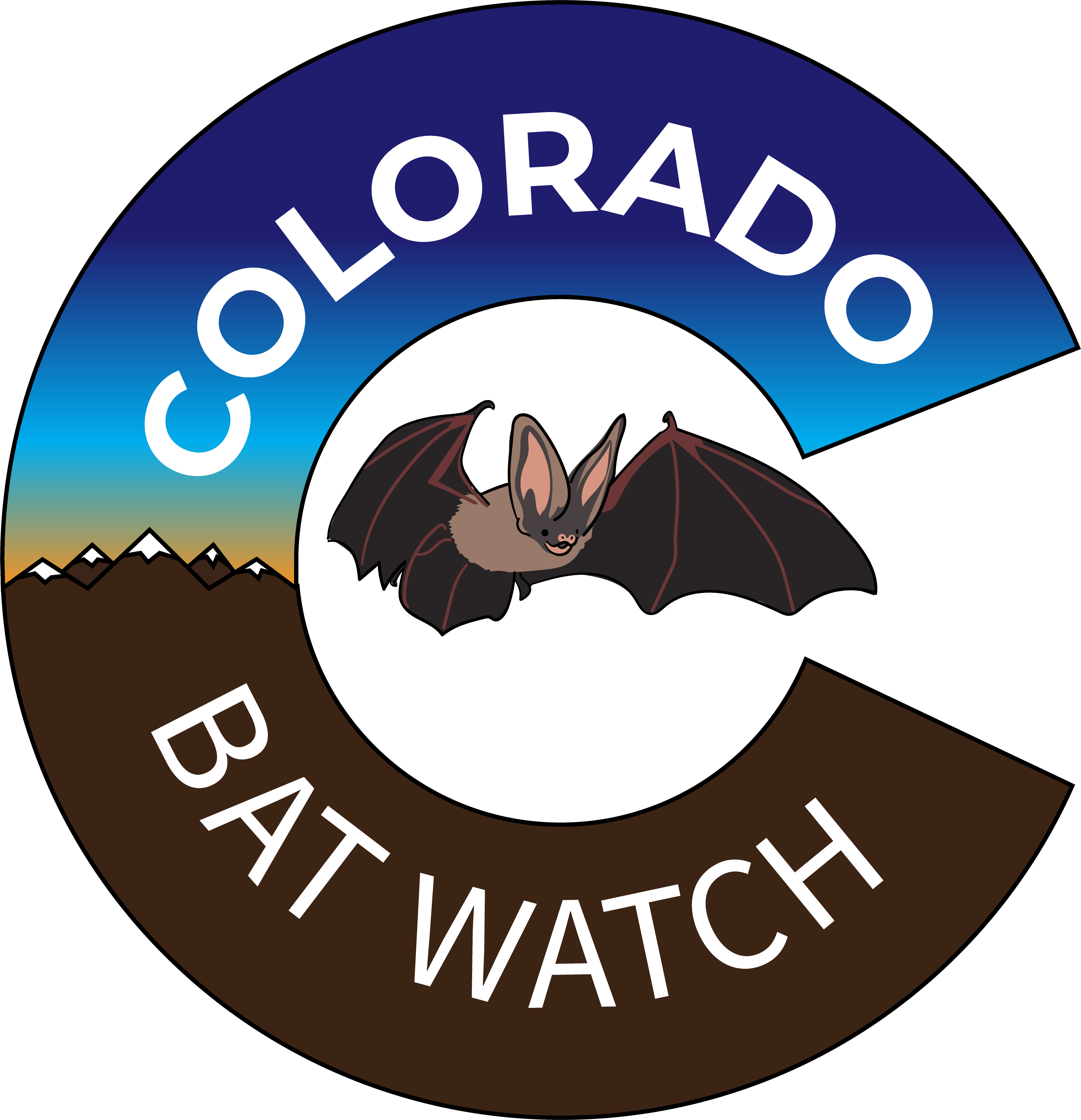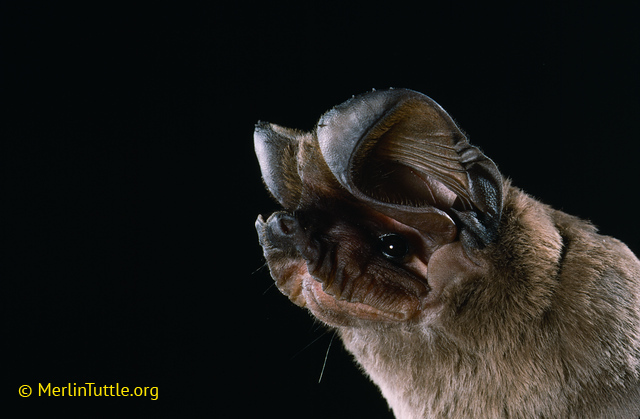
Big free-tailed bat
Learn About Bats
Bats are beneficial to humans and ecosystems.
When we protect bats, we are protecting the health of our communities, our ecosystems, and our crops. Bats eat insects and control pests that harm crops, damage forests, and transmit diseases. Bat conservation is also vital for agriculture because bats pollinate or disperse seeds of more than 1,000 species of plants globally, including many that we rely on for food such as bananas, mangos, and cocoa.
What kind of bat are you?
Not seeing the quiz on your browser, click here to open it in a new tab!
Meet Our Bats
Colorado is home to 19 bat species. Bats can be found in any part of Colorado, from eastern prairies to mountain forests to western canyons, and from small towns to downtown Denver. Unfortunately, relatively little is currently known about the population status of most species of bats in Colorado. That’s where you come in! Get involved and help us generate knowledge about bats.
Click on a species name below to learn more about that Colorado bat species.
The species profiles below have been adapted from the detailed species accounts developed by the Colorado Bat Working Group and Colorado Parks and Wildlife.
Allen’s big-eared bat
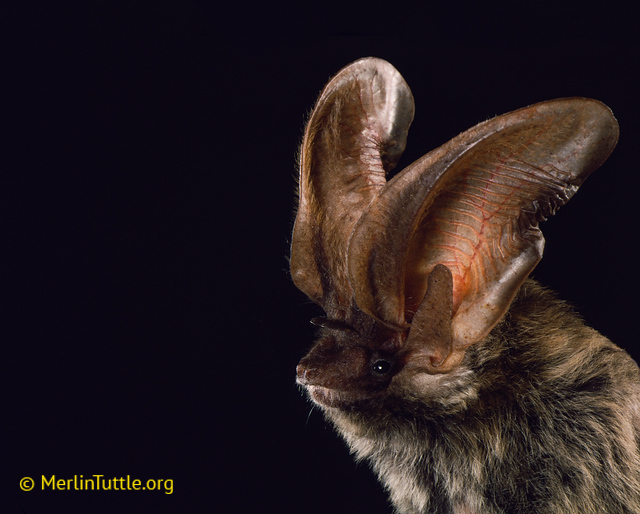
Allen's big-eared bat
(Idionycteris phyllotis)
Family: Vespertilionidae
Where can it be found in Colorado? Southwestern counties in shrublands, ponderosa pine lands, pinyon-juniper woodlands, and riparian cottonwood galleries.
When can it be found in Colorado? Only an occasional visitor to Colorado.
What does it eat? Mainly moths, but also various beetles and ants.
Where does it roost? Associated with scrub woodland, forests, and with cliffs and rocky slopes, suggesting a roosting relationship with trees, caverns (including mines) and rock fissures.
Big brown bat
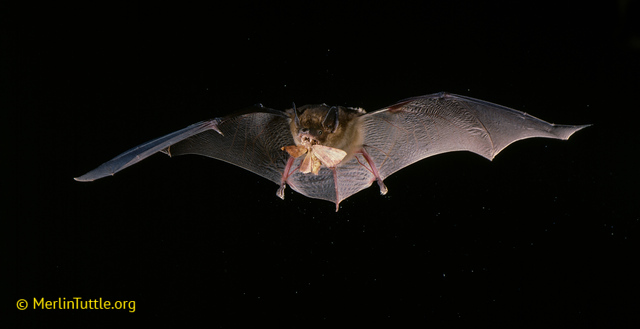
Big brown bat
(Eptesicus fuscus)
Family: Vespertilionidae
Where can it be found in Colorado? Just about everywhere, especially in towns and cities.
When can it be found in Colorado? Year-round resident, hibernates through winter.
What does it eat? A variety of larger, flying insects and beetles.
Where does it roost? Anthropogenic structures including buildings and bridges, as well as mines, caves, rock crevices, and even large diameter tree snags. Hibernates in mines, caves, fissures, storm sewers and a variety of other places.
Fun Facts: Given their habit of living near humans, big brown bats may be important in keeping urban insect populations under control. This bat has been studied widely for its remarkable homing ability. It can return to its roost site from distances of over 400 miles in less than a month.
Big free-tailed bat

Big free-tailed bat
(Nyctinomops macrotis)
Family: Molossidae
Where can it be found in Colorado? Widespread occurrence across Colorado in rocky or canyon country.
When can it be found in Colorado? Seasonally during the summer. Migrates to warmer climates for winter.
What does it eat? Moths seem to be the mainstay of their diet, although little data has been collected.
Where does it roost? Predominantly in the crevices of cliff faces, but also in buildings, caves, and tree cavities.
Brazilian free-tailed bat
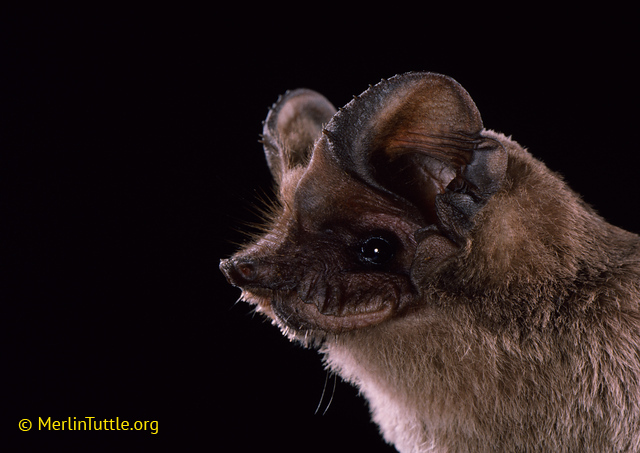
Brazilian free-tailed bat
(Tadarida brasiliensis)
Family: Molossidae
Where can it be found in Colorado? Western, south central and southwest parts of Colorado and possibly northeast Colorado, most commonly associated with dry low elevation habitats.
When can it be found in Colorado? Seasonally during the summer. Migrates to Mexico and Central America for winter.
What does it eat? Mostly small moths, although beetles, bugs, mosquitoes and wasps are also taken.
Where does it roost? Most common natural roosts are caves and rock crevices on cliff faces, but also roosts in abandoned mines and tunnels, highway bridges and large culverts, buildings, and bat houses.
Fun facts: You can see one of the largest, northernmost known roost sites of this species in the West, at Orient Mine in the San Luis Valley. This colonial bachelor roost site is the largest known bat roost in Colorado which houses between 100,000-250,000 males throughout the summer.
California myotis
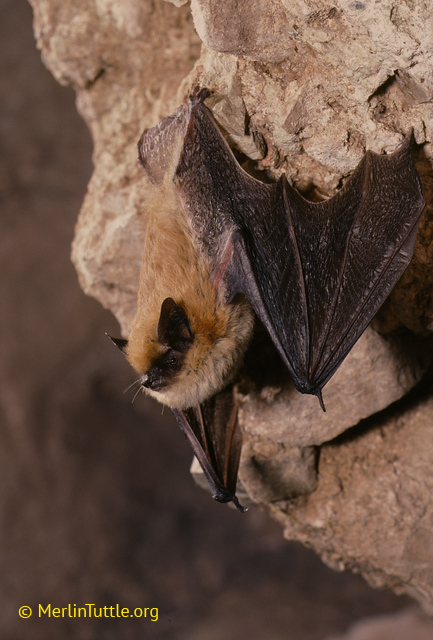
California myotis
(Myotis californicus)
Family: Vespertilionidae
Where can it be found in Colorado? At lower elevations in valleys and canyons along the Western Slope in semi-desert habitats, including pinyon juniper woodlands and other scrub.
When can it be found in Colorado? Possibly year round (winter range is unknown, but may hibernate in the state).
What does it eat? Typical food includes flies, moths and spiders.
Where does it roost? Crevices, mines, caves, buildings (e.g. porches, eaves and outbuildings), beneath bridges, in trees and shrubs, and behind loose bark
Canyon bat

Canyon bat
(Parastrellus hesperus)
Family: Vespertilionidae
Where can it be found in Colorado? At lower elevations on the Western Slope and in the extreme southeast. This is a bat of the desert, living in arid canyons or dry shrublands, near water.
When can it be found in Colorado? Year round, the only hibernaculum discovered to date in Colorado was in a mine at 9,500 feet.
What does it eat? Small moths, beetles, mosquitoes and other flies.
Where does it roost? Roosts in dense vegetation and beneath rocky slabs. Rarely roosts in human-made structures. Does not use mines or caves much except as hibernacula.
Fun Facts: The canyon bat is the smallest of Colorado’s bats and may be active on warm winter nights.
Eastern red bat
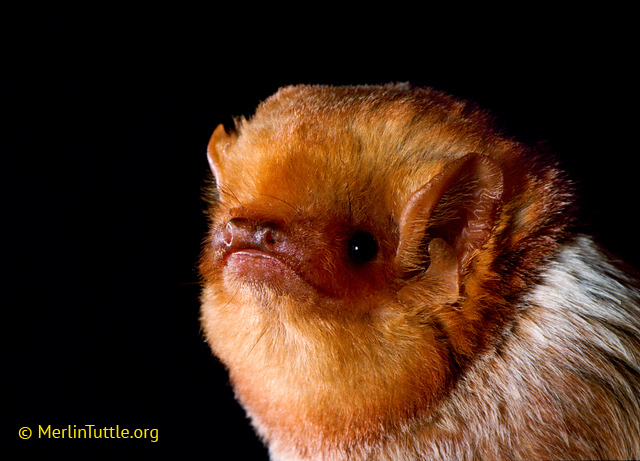
Eastern red bat
(Lasiurus borealis)
Family: Vespertilionidae
Where can it be found in Colorado? Rare in Colorado, mostly found in riparian woodlands (and urban landscaping) along the South Platte and Arkansas rivers and major tributaries.
When can it be found in Colorado? Seasonally during summer. Migrate to southern states to hibernate in winter.
What does it eat? Moths, grasshoppers, crickets, and insects attracted to lights.
Where does it roost? Deciduous trees, such as cottonwoods or fruit trees.
Fun Fact: Hibernation occurs in the southern states where these bats may arouse and forage throughout the winter. Red bats survive at subfreezing temperatures and are able to arouse readily from deep sleep.
Fringed myotis
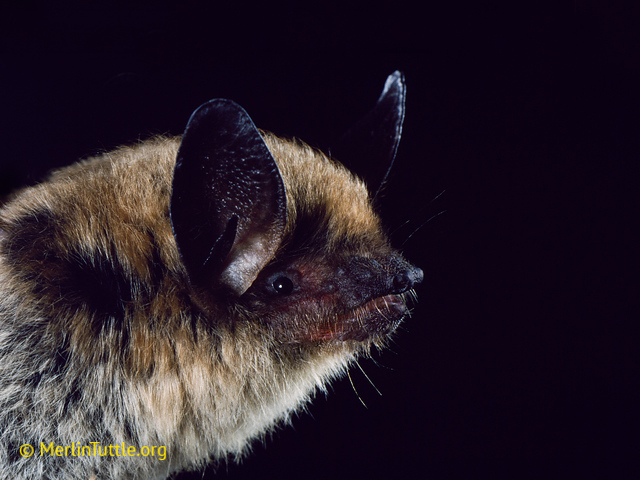
Fringed myotis
(Myotis thysanodes)
Family: Vespertilionidae
Where can it be found in Colorado? Scattered populations are found on the Western Slope, along the foothills of the Front Range and the mesas of southeastern Colorado. Prefer moderate elevations in coniferous forest and woodland.
When can it be found in Colorado? Probably year round. Where the species has been studied well, migration seems not to be extensive.
What does it eat? Moths, daddy longlegs, beetles and other insects.
Where does it roost? In rock crevices, caves, mines, buildings and trees. Known to hibernate in caves and buildings.
Hoary bat
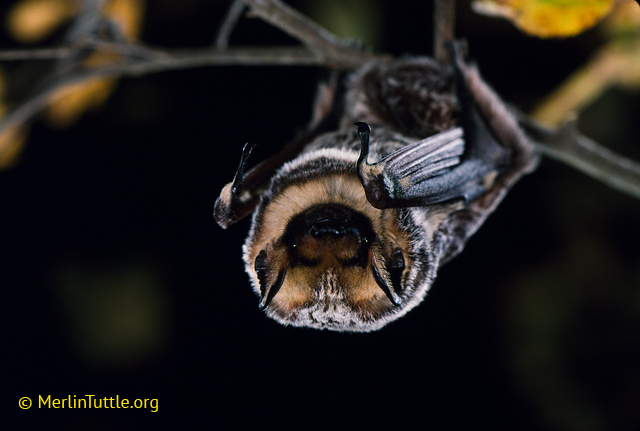
of Merlin Tuttle
Hoary bat
(Lasiurus cinereus)
Family: Vespertilionidae
Where can it be found in Colorado? Probably occurs statewide from the plains to the timberline, in any habitat with trees.
When can it be found in Colorado? Summer, there is no record of hibernation in Colorado.
What does it eat? Prefers moths but also feeds on beetles, wasps, grasshoppers and even small bats.
Where does it roost? Primarily in foliage of both coniferous and deciduous trees.
Fun Fact: The hoary bat is unique in having the widest range of any North American bat – from Argentina and Chile all the way to northern Canada. They also occupy the widest variety of habitats of any New World bat.
Little brown bat
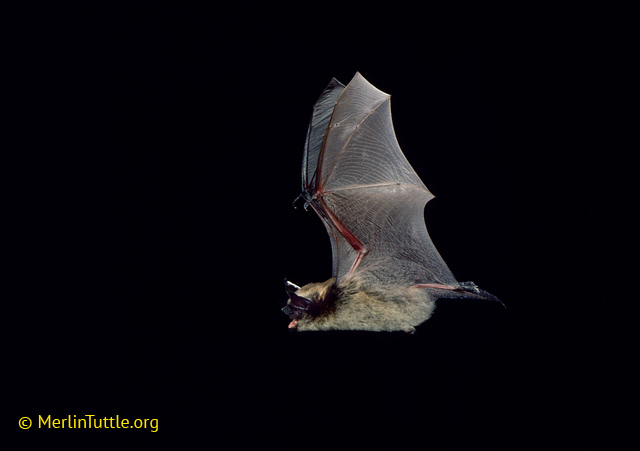
Little brown bat
(Myotis lucifugus)
Family: Vespertilionidae
Where can it be found in Colorado? Statewide in suitable habitat as high as 11,000 feet. Riparian woodlands in the mountains and lower valleys as well as urban wooded areas.
When can it be found in Colorado? Possibly year round. Some hibernate in Colorado, but winter habits in the state are difficult to study.
What does it eat? Primarily aquatic insects, including caddis flies and midges, but also moths, mosquitoes and other flies.
Where does it roost? Tree cavities, beneath tree bark, rock crevices, caves, and anthropogenic structures such as buildings, bridges and attics. Hibernation sites in other parts of North America include caves, mines and buildings.
Fun Fact: Little brown bats forage by knocking prey from the air with a wingtip, capturing it in the membrane between the legs and lifting it to the mouth.
Long-eared myotis
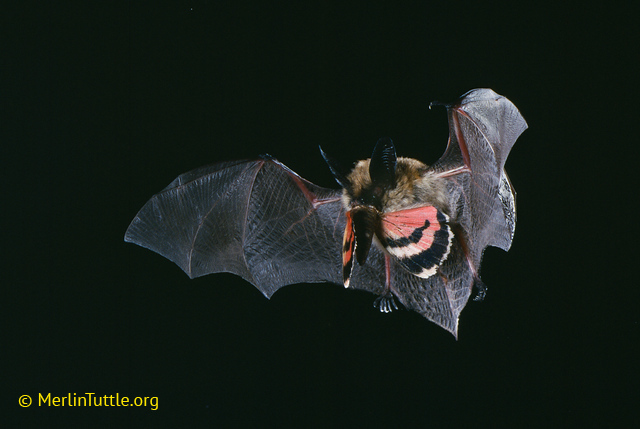
Merlin Tuttle
Long-eared myotis
(Myotis evotis)
Family: Vespertilionidae
Where can it be found in Colorado? At moderate elevations throughout western and central Colorado, favoring ponderosa pine and some piñon-juniper woodlands.
When can it be found in Colorado? Possibly year round. Late fall activity has been documented in caves and mines, suggesting possible hibernation, but individuals have never been found in winter.
What does it eat? Moths and small beetles, as well as flies, lacewings, wasps, caterpillars, and true bugs.
Where does it roost? Trees (often behind loose bark), caves, abandoned mines and other sheltered areas.
Long-legged myotis
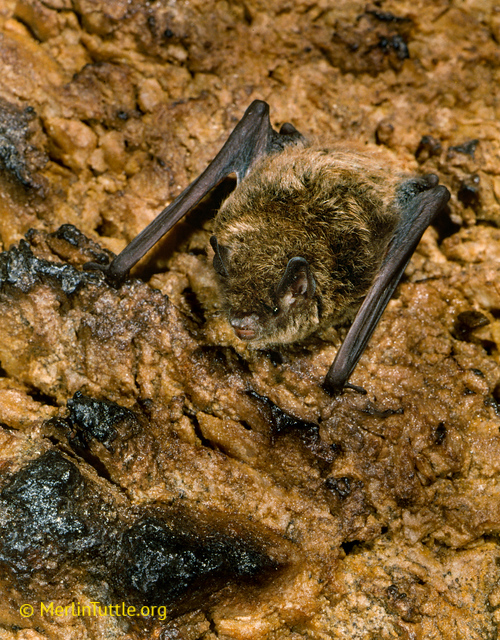
of Merlin Tuttle
Long-legged myotis
(Myotis volans)
Family: Vespertilionidae
Where can it be found in Colorado? Across western and central Colorado, from moderate to high elevations, in wooded areas in foothills, mountains and high plateaus. Typically in montane or subalpine forest, ponderosa pine woodland, piñon-juniper woodland and montane shrubs with willows or well-watered stands of sagebrush.
When can it be found in Colorado? Possibly year round. May hibernate locally, with only short migrations, as late fall activity has been observed at mines and caves.
What does it eat? Mostly moths.
Where does it roost? Abandoned buildings, cracks in the ground, cliff and rock crevices, exfoliating tree bark, and hollows within snags, as well as caves or mines.
Pallid bat
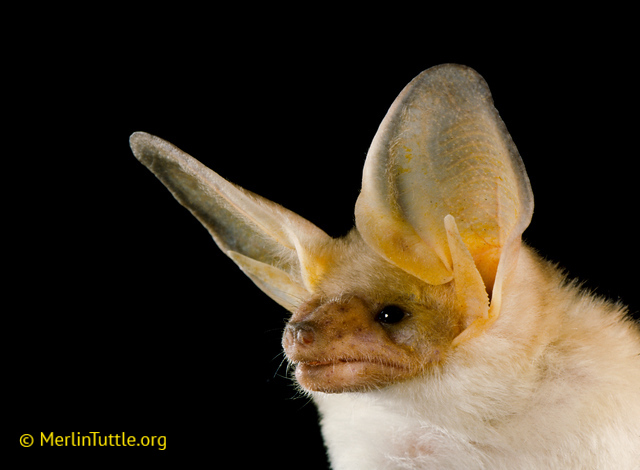
Pallid Bat
(Antrozous pallidus)
Family: Vespertilionidae
Where can it be found in Colorado? Likely throughout Colorado at lower elevations in deserts and grasslands near rocky outcrops, including semi desert scrub and piñon-juniper woodlands to about 7,000 feet.
When can it be found in Colorado? Probably year round, since they are not migratory in other parts of their range, though there is no direct evidence of their winter habits here.
What does it eat? Mainly flightless ground-dwelling arthropods, such as crickets, grasshoppers, beetles, scorpions and spiders. Also large moths and lizards.
Where does it roost? Rock crevices, shallow caves, overhangs and man-made structures.
Fun Fact: The Pallid bat hunts the most venomous scorpion in North America (the Arizona bark scorpion), and is unfazed even if stung many times.
Silver-haired bat
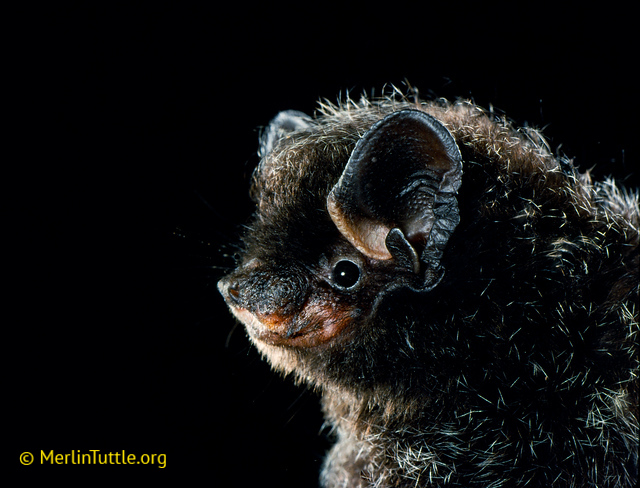
Silver-haired bat
(Lasionycteris noctivagans)
Family: Vespertilionidae
Where can it be found in Colorado? Statewide but is more common in the forested mountains at elevations up to 10,000 feet.
When can it be found in Colorado? Seasonally in summer. Occasionally has been found hibernating in mines in Colorado, but probably migrates elsewhere for winter.
What does it eat? Prefers moths, flies, beetles and wasps, but also eats other insects.
Where does it roost? Primarily in trees (generally older trees with cavities and loose bark) and under rocks.
Spotted bat
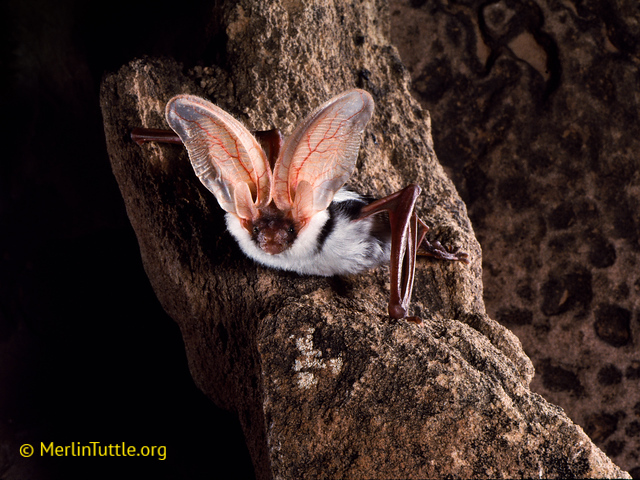
Spotted bat
(Euderma maculatum)
Family: Vespertilionidae
Where can it be found in Colorado? May be relatively widespread, in a variety of habitats, including ponderosa pine, piñon-juniper woodland and shrub desert. May prefer ponderosa pine forests or areas with cliffs and water.
When can it be found in Colorado? Unknown – little is known about its hibernation or annual movement patterns.
What does it eat? Preferred food is moths. Other food items include beetles, katydids and grasshoppers.
Where does it roost? Typically roost in cracks and crevices in canyon walls.
Fun Facts: Apparently only the abdomens of prey are eaten as the spotted bat has been observed to remove and discard wings and heads of captured prey.
Townsend’s big-eared bat
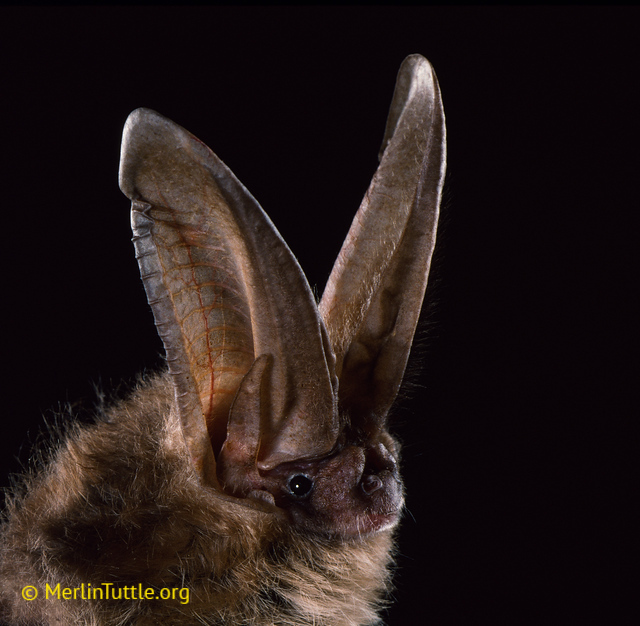
Townsend's big-eared bat
(Corynorhinus townsendii)
Family: Vespertilionidae
Where can it be found in Colorado? Uses a wide variety of habitat types, including coniferous forests, deserts, native prairies, riparian communities, active agricultural areas. Distribution is strongly correlated to the availability of caves and cave-like roosting habitat (including abandoned mines).
When can it be found in Colorado? Year round. Hibernates in Colorado in winter.
What does it eat? Moth specialist with over 90% of its diet composed of moths.
Where does it roost? Most frequently in caves and mines. Also in buildings, bridges, rock crevices and hollow trees.
Tri-colored bat
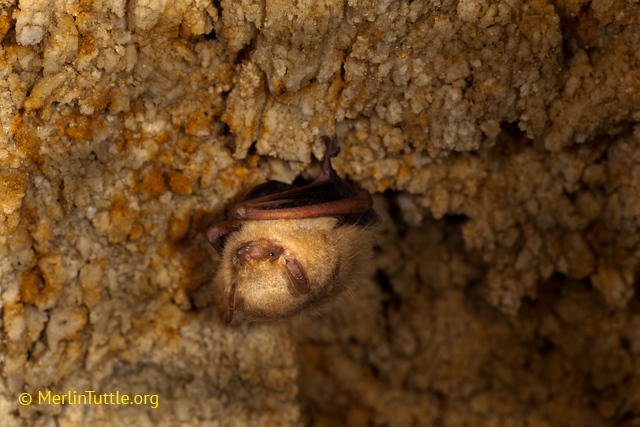
Merlin Tuttle.
Tri-colored bat
(Perimyotis subflavus)
Family: Vespertilionidae
Where can it be found in Colorado? Scarce but mostly found in eastern Colorado, in woodlands and pastures, often associated with urban settings.
When can it be found in Colorado? Year round, not strongly migratory, typically spending the summer in the same general region as the hibernaculum.
What does it eat? Smaller insects, including moths, flies and beetles.
Where does it roost? Buildings, trees, and cliffs.
Western small-footed myotis
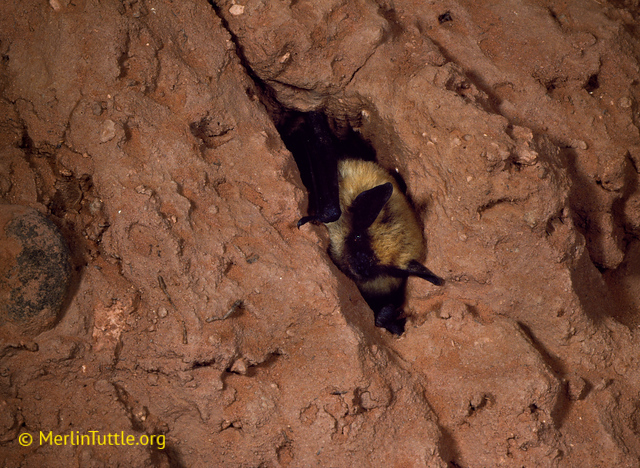
crevice, courtesy of Merlin Tuttle.
Western small-footed myotis
(Myotis ciliolabrum)
Family: Vespertilionidae
Where can it be found in Colorado? Statewide in suitable habitat. Most common in canyon country of the Western Slope and rocky areas of northeastern and southeastern Colorado. Little is known of habitat preferences, more common at low elevations.
When can it be found in Colorado? Year round. Hibernates in caves or mines.
What does it eat? Small flying insects such as flies, small beetles and winged ants.
Where does it roost? Buildings, mines, and under bark on trees, beneath rocks on the ground, in caves and mines.
Yuma myotis

Merlin Tuttle.
Yuma myotis
(Myotis yumanensis)
Family: Vespertilionidae
Where can it be found in Colorado? Not common in Colorado. At moderate elevations in valleys in western and southern Colorado. Typical habitat is piñon-juniper woodland and riparian woodland in semi-desert valleys, tied closely to water.
When can it be found in Colorado? Seasonally in summer. Apparently they do not hibernate in Colorado although winter habits are unknown.
What does it eat? Mostly moths, flies and beetles, also leafhoppers, caddis flies, lacewings and crane flies.
Where does it roost? Bridges, buildings, cliff crevices, caves, mines, abandoned swallow mud nests, and trees.
Bats in the U.S. face many threats and need our help.
Bats face numerous threats in Colorado, including habitat loss, energy development, and pesticides. In addition, hibernating bats in Colorado may be impacted by white-nose syndrome (WNS), a pathogen that has killed millions of bats in the eastern and midwestern U.S. since 2006. The fungus that causes WNS was detected in Colorado for the first time in July of 2022.
White-Nose Syndrome
White-nose syndrome (WNS), caused by the fungus Pseudogymnoascus destructans, is a disease that impacts hibernating bat populations. It spreads by direct contact from an infected bat to a healthy individual or by contact with fungal spores on various surfaces bats come in contact with, such as cave walls. Hibernating bats infected with white-nose syndrome may rouse from hibernation in an attempt to deal with the fungal infection, using important energy reserves needed to survive the winter and putting them in jeopardy of starving before winter is over.
White-nose syndrome was first documented near Albany, New York in 2006 and has spread to most U.S. states and a number of Canadian provinces. Sadly, the impact has been massive: populations frequently see declines of 75% or greater and the bat death toll is in the millions.
The fungus that causes WNS was detected in Colorado for the first time in July of 2022. Finding out where bats are roosting, and monitoring bat populations through Colorado Bat Watch can help experts and officials respond to WNS in Colorado.
Humans may transmit WNS from infected sites to clean sites. To avoid the risk of spreading the fungus that could kill bats in Colorado’s caves/bat roosts, please do not use ANY gear or clothing in Colorado that you have used in caves/bat roosts east of the Mississippi River. Please clean and disinfect all gear and clothing used in Colorado caves and roosts before entering any other caves/roosts in the state. See the decontamination guidance for cavers and researchers at whitenosesyndrome.org, and the information for cavers accessing caves in National Forests here.
Learn more about White Nose Syndrome and what you can do to help prevent the spread of WNS at the links below:
Colorado Parks and Wildlife – White Nose Syndrome in Bats
U.S. Forest Service – White Nose Syndrome Management in the Rocky Mountain Region
Habitat Loss
Loss of roosting and foraging habitats is one of the biggest threats to bats in Colorado and worldwide. Roost sites are critical resources for bats, and can be lost due to human uses. For example, physical barriers at caves and mines (often put in place due to human safety concerns) can prevent bats from accessing roost sites if they are not designed properly. High levels of human use can also keep bats from using roosts in caves and mines. For species that roost in trees, development or other activities that permanently remove trees can eliminate roost sites. Many bat species also roost in human structures, such as abandoned buildings. Some species need to use buildings and other human structures because natural roost sites like trees have been destroyed, and others benefit from using human structures in addition to natural roost sites. Demolition of buildings and other human structures used by bats, or removal of bat colonies from human structures, can result in loss of important roost sites. Sometimes this is unavoidable, (e.g. in cases when bat use of an occupied structure poses human health risks). Fortunately, there are mitigation actions that can be taken to reduce the impact of such situations. Alternate roost sites can be constructed near the structure to be demolished, or bats can be excluded from buildings using non-lethal measures while bats have departed the structure.
Energy Development
Many bat mortalities have been documented at wind energy facilities. It is not clear why bats approach wind turbines. Bats that approach wind turbines may die from collisions or hemorrhaging of lung tissues from the change in air pressure near the turbine blades. This is one of the leading causes of bat mortality in North America, particularly for migratory tree roosting species, and could result in significant declines of populations of several bat species. Other types of energy development can also result in loss of habitat and other impacts to bats.
Pesticides
Bats need clean water and insects for food and may be at risk from pesticides. Bats eat a high volume of insects. As a consequence, there is concern that toxic pesticides could bioaccumulate in bats and have impacts (e.g. reduction of energy reserves, impaired reproductive processes) that could limit bat populations. Pesticides can also reduce the overall abundance of insects, which reduces foraging resources for bats.
Learn More About Threats to Bats
Frequently Asked Questions
Why should we protect bats?
When we protect bats, we are protecting the health of our communities, our ecosystems, and our crops. Bats eat insects and control pests that harm crops, damage forests, and transmit diseases. Bat conservation is also vital for agriculture because bats pollinate or disperse seeds of more than 1000 species of plants globally, including many that we rely on for food, such as bananas, mangoes, and cocoa.
What can I do to help bats?
Find out about opportunities to get involved and help bats with Colorado Bat Watch! You can also donate to Colorado Bat Watch.
When will Colorado Bat Watch have opportunities for volunteers to monitor bat colonies?
I found an injured, displaced, sick, or dead bat. What should I do?
If you have found an injured, displaced, or sick bat, or want to remove a live bat from your home, please follow the instructions found here. Do not attempt to handle or rehabilitate the bat on your own. Instead, you can contact the Colorado BatCREW toll free at 866-909-2287. Leave them a message with your name and contact number, and tell them about your bat situation. Their on-call coordinator will return your call and coordinate with one of their volunteers to get the help required. Colorado BatCrew is an association of Colorado licensed wildlife rehabilitators and transport volunteers dedicated to bat rescue and rehabilitation. If you would like more info, you can check out their website.
If you find a dead or sick bat, please report the sighting to Colorado Parks and Wildlife as quickly as possible by calling 303-291-7771 or emailing wildlife.batline@state.co.us. If you see a band on the bat’s wing or a small device on the back of a bat, or if you find five or more dead bats in a small area, follow the instructions here to report these types of observations to Colorado Parks and Wildlife.
Because bats can be affected by health problems, including rabies, you should never directly handle bats. If you must move a bat, please follow the following steps (courtesy of Bat Conservation International):
- Do not handle the bat with bare hands. Use heavy leather gloves and wear long sleeves.
- Do not chase the bat. Simply wait quietly until the bat lands. Then cover it with a small container such as a cardboard box.
- Gently, slip a piece of cardboard between the container and the surface where the bat has landed. Be careful that no part of the bat is caught between the container and the cardboard.
- Slowly turn the container over. Make certain your container is secure, but not airtight. Small holes should be made for ventilation.
- Place the container in a quiet, safe place and wait until dark before releasing the bat outdoors. A bat released during the day is vulnerable to predators. If the bat must remain in the box for several hours (as you wait for dark to release the bat), prepare the container before capturing the bat by taping a soft t-shirt in the box and creating folds in the fabric for the bat to hang from. Do not use terry cloth (towel) fabric (the bat’s claws may become entangled).
- When it’s time to release the bat, place the container in an elevated location. A tree limb, a ladder or a second-story deck are good options. Bats need to drop from a high point to catch flight.
- Using a cloth and gloves, carefully open the container and turn it on its side so the bat can crawl out on its own.
- With a flashlight, watch the bat fly away. If the bat does not fly, it may be injured, disoriented, dehydrated or sick. Contact a specially trained bat rehabilitator or bat rescuer. You can contact the Colorado BatCREW toll free at 866-909-2287. Report sick or injured bats to Colorado Parks and Wildlife as quickly as possible by calling 303-291-7771 or emailing wildlife.batline@state.co.us.
- Do not feed bats and do not release bats in harsh weather. Both could lead to severe injury or death of the bat.
Do not attempt to pick up or capture a live bat.
If you need to dispose of a dead bat on your property, follow the recommendations of Colorado Parks and Wildlife here. If you aren’t sure if the bat is dead, do not handle it.
If you aren’t able to get the help you need using the above resources, call your city or county animal control office.
I see a bat out during winter. Is this normal? What should I do?
If you observe a bat that is active in winter, please report the sighting to Colorado Parks and Wildlife as quickly as possible, by calling 303-291-7771 or emailing wildlife.batline@state.co.us. Bats typically migrate to warmer climates or hibernate in winter. If a bat is active in winter, it could mean that the bat has white-nose syndrome. Hibernating bats infected with white-nose syndrome may rouse from hibernation in an attempt to deal with the fungal infection. It’s critical to quickly report observations of bats that are active in winter so that biologists can detect white-nose syndrome and initiate response plans to try to protect bat populations.
Do bats carry rabies?
Though the proportion of free-ranging bats affected by rabies is estimated to be less than 0.1% (less than 1 in 1,000 bats), rabies can be fatal for humans and other mammals, and care should be taken not to touch bats. Even dead bats can still harbor the virus and should not be touched without protective equipment.
A person or domestic animal has been exposed to a bite, scratch or saliva from a live or dead bat. What should the person or pet owner do?
If a person or domestic animal has been exposed to a bite, scratch, or saliva from a live or dead bat, immediately call your healthcare provider or veterinarian (if a pet has been exposed) and your local public health department for further guidance.
I want to remove bats from my home or property. How can I do this humanely?
Bats can be good neighbors, so consider allowing them to remain if possible. Bats benefit us by controlling pests, pollinating crops and dispersing seeds. Bats often roost in buildings and other man made structures because they provide stable temperatures, protect bats from predators and provide a safe space for resting and raising young. Some species need to use buildings because natural roost sites like trees have been lost or destroyed.
Get advice on how to live with bats.
Bat Conservation International works to conserve the world’s bats and their ecosystems to preserve a healthy planet. Check out their website for advice on how to live with bats.
If allowing bats to stay on your property is not possible, removing a bat or a group of bats can be done humanely and safely. Below are resources to help you humanely remove them.
Urban Wildlife Rescue – offers phone consultations (free) and on-site humane exclusion or removal of bats (for a fee). Call 303-340-4911 or email them for advice and assistance.
Bat World Sanctuary – Bat World Sanctuary provides a nationwide list of experts who have volunteered to help rescue and remove bats.
Bat Conservation International -Bat Conservation International provides information on how to remove bats safely and humanely.
Animal Help Now – Animal Help Now is a nationwide hotline for help with emergencies and nuisance situations.
If you aren’t able to get the help you need using the above resources, call your city or county animal control office.
Thank you for taking the time to learn how to handle the removal. You are making a difference in protecting bat species and we appreciate your efforts!
What do we know about bats and COVID-19?
Scientists are still doing research to find out how the virus responsible for the COVID-19 pandemic entered the human population. Bats and other wildlife can be hosts to coronaviruses, including some that are closely related to the virus that caused COVID-19. If left protected and undisturbed, bats and other wildlife with coronaviruses in the wild are not a threat to human health. Regardless of where the disease originated, bats and other wildlife do not spread the disease among humans – only humans spread COVID-19 to other humans. You cannot catch COVID-19 from a bat.
Should I worry about bats flying close to me?
Bats may fly close to you in search of insects but their amazing echolocation abilities will prevent them from landing on you or bumping into you. They also have well developed eyes and can see. All bats in Colorado feed on insects. So, when a bat flies close to you, relax and enjoy watching their impressive flying and echolocation skills!
Are bats mammals?
Yes – bats are the only flying mammals. They belong to their own order, Chiroptera, and may share a common ancestor with the mammals that eventually evolved into horses, whales and dogs.
Resources for Learning More
Community science projects, organizations, and media
Other bat community science projects you can join
Colorado organizations involved in bat research & conservation
Bats in Colorado – Colorado Parks and Wildlife
National organizations involved in bat research & conservation
Bat Conservation International
North American Bat Monitoring Program
White Nose Syndrome Response Team
North American Bat Conservation Alliance
Merlin Tuttle’s Bat Conservation
Selected Media
Fungus linked to a fatal bat disease found in southeastern Colorado. Colorado Parks and Wildlife, July 2022.
New report forecasts alarming loss of North America’s hoary bats. Bat Conservation International, September 2021.
White-nose Syndrome has devastated bats, but some are developing immunity. National Geographic, July 2021.
Here is why you are seeing more bats in Colorado. Out There Colorado, June 2021.
White-nose syndrome killed over 90% of three North American bat species. Bat Conservation International, April 2021.
Colorado bat swarms may be vulnerable to white-nose syndrome. The Wildlife Society, April 2021.
The virus, the bats and us. New York Times, December 2020.
Vaccination may help protect bats from deadly disease. U.S. Geological Survey, May 2019
